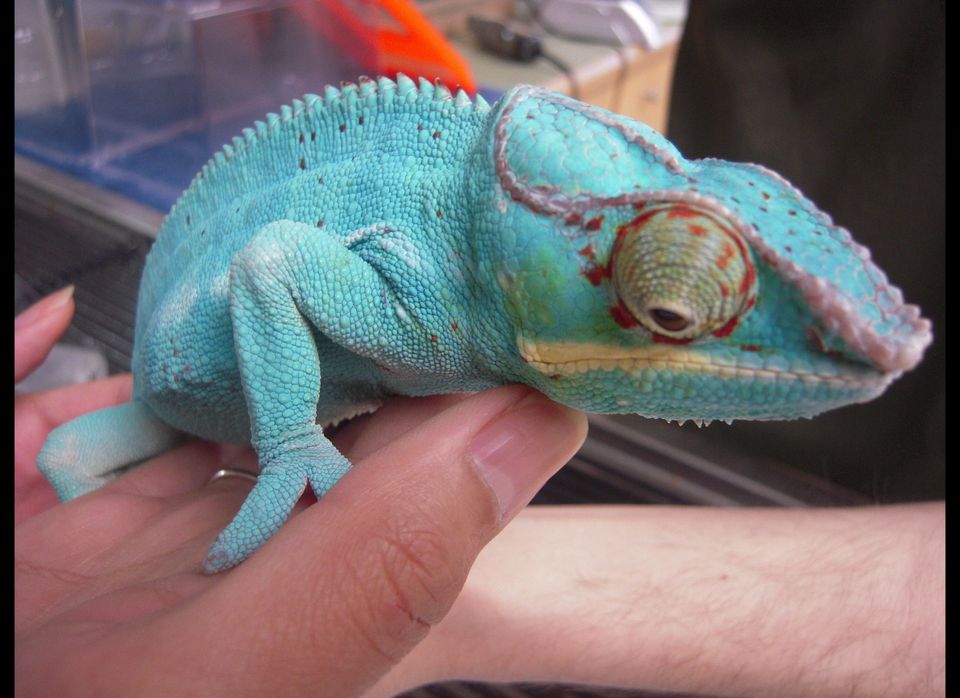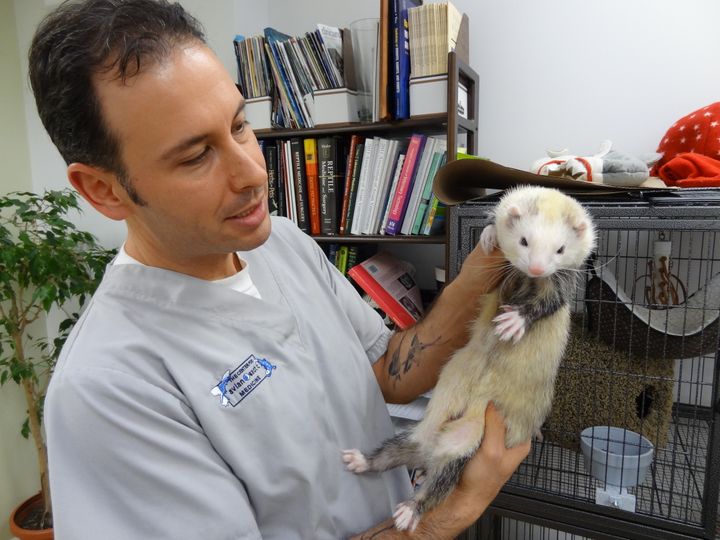
Part of a series investigating the complex links between human, animal and environmental health: The Infection Loop.
Dr. Anthony Pilny had just finished neutering a baby chinchilla when we met under the watchful eyes of his Manhattan clinic's reptilian mascot: an Egyptian Uromastyx named Xama. A few feet away, nearly a dozen canaries and finches and two lop-eared house rabbits flanked the front door of The Center for Avian and Exotic Medicine.
Pets like these have been receiving increased attention from infectious disease experts. As cute and innocent as the animals may look, many are the namesakes of unfriendly things like bird flu, monkeypox and rat bite fever. And, as experts warn, it is common for reptiles to carry potentially deadly pathogens, including salmonella. 
Xama's gaze followed Dr. Pilny and me as we walked through the lobby, past a series of offices, labs, an operating table, a pair of sleeping ferrets (used for blood transfusions) and then into a large room -- this one guarded by Monico, a blue-fronted Amazon parrot. Glass and metal cages surrounded us, each housing a scaly, feathered or furry creature.
Some of these pets had been bred in the U.S., Dr. Pilny told me. Others were likely plucked and shipped from the forests of Africa, South America or other tropical regions. There's also a good chance some of these animals were brought in illegally, although he has no way to know for sure.
"I think most people are oblivious to how serious the illegal pet trade is and how much it still happens, and how it may represent sources of contagion," said Dr. Pilny.
Of course, the legal pet trade is not void of risks either. An animal can go from roaming a rainforest on one side of the globe to sleeping in a child's bedroom on the other within the span of about four days without breaking any laws -- and without having undergone any screening for disease.
'EARTHQUAKE-TYPE STUFF'
An estimated three of every four emerging infectious diseases in humans originate in wildlife. That's not to say that all of the estimated one million animal diseases can make the jump to humans. But when they do, which qualifies the disease as zoonotic, devastating consequences can result. Of particular concern is when the pathogen becomes capable of direct human-to-human transmission.
"We're dealing with rare events, but the magnitude is potentially huge," said Peter Daszak, president of EcoHealth Alliance, a New York-based organization of scientists dedicated to the dual goals of conservation and public health. "This is earthquake-type stuff." He referenced HIV, SARS and Nipah -- all viruses that originated in animals before infecting humans. The fictional infection in the movie "Contagion" was based on a recent outbreak of Nipah virus: born in bats, passed on to pigs and then contracted by humans.
Daszak's research has found that tropical regions including West Africa, Bangladesh and Malaysia, home to the first Nipah virus outbreak in 1999, are the most likely sources of the next great pandemic, thanks in large part to rapid human development alongside dense populations of wildlife.
Dr. Lisa Conti, principal at One Health Solutions and former director of the Division of Environmental Health for the Florida Department of Health, points to "myriad issues" associated with the global pet trade.
She is a leader in an emerging movement called "One Health." At its core, the movement seeks more recognition of the connections between the health of the environment, animals and human beings.
"The exotic pet trade is an interesting microcosm of One Health," she told HuffPost. "You've got habitat destruction to get at the animals, a high mortality rate of the animals taken out, stress on the people who are now in very close contact with the animals and then the threat to human health from emerging diseases."
And it's not only the animals themselves that could precipitate the next pandemic; infected insects can also hitch a ride in mammalian fur or reptilian skin folds. In Florida, importation of reptiles carrying tropical bont ticks infected with African tick fever or heartwater threatens people and agriculture.
Researchers who subscribe to this One Health multidisciplinary perspective are attempting to address the global pet trade issue through improved surveillance of animals in the wild, tighter regulations at the borders and greater collaboration with the pet trade industry, as well as educating consumers about the potential risks of animal-borne disease.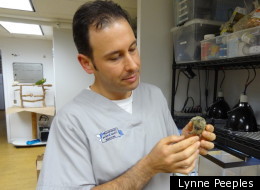
"I always talk to new owners," Dr. Pilny told The Huffington Post, as he held up a 7-week-old Greek tortoise in the palm of his hand. "There's realistic concern about zoonotic disease."
OF RODENTS AND MEN
A frightening reminder of this reality came in April 2003, when about 800 rodents arrived in Texas to be sold as pets. The shipment from Ghana, West Africa, included representatives of nine different species including Gambian giant pouched rats, dormice and rope squirrels. Over the following few months, 93 people came down with monkeypox across six midwestern states and New Jersey. Fortunately, no one died. But the smallpox-like illness can cause a severe fever and rash and is especially dangerous for young children. Mortality rates from the disease are estimated around 10 percent in Africa.
An investigation eventually traced the probable source of the U.S. outbreak back to infected prairie dogs purchased from a single pet store: Phil's Pocket Pets of Villa Park, Ill. The store's prairie dogs had been housed close to imported Gambian rats. Scientists detected monkeypox in some of these Gambian rats, as well as in a few of the imported dormice and squirrels, leading them to believe at least one rodent in the shipment had caught monkeypox in the wild and brought it on board.
"The monkeypox outbreak was one of the major keys for us to start looking at regulations," said Dr. Nina Marano, branch chief of quarantine and border health services at the U.S. Centers for Disease Control and Prevention. "We found that the rodents being brought in for the pet trade, while appearing to be healthy themselves, were quite capable of transferring exotic infections."
The CDC implemented emergency legislation on the importation of African rodents. However, as Dr. Marano noted, the pet trade is a very fluid market: "If one door closes, several more open."
Rodents continue to enter the U.S. from all over world, including Europe and Asia. While it's possible that some of these rodents harbor monkeypox, experts are more concerned that they could carry one of the several hundred other diseases that are known to infect that group of animals -- some of which can also infect people.
An Asian outbreak of avian flu in 2003 and 2004 also triggered a response from the CDC: a subsequent ban on the importation of birds from suspect countries. Yet again, experts fear the rules may not be enough to thwart a future disease outbreak.
"If you are a bird dealer and overnight are banned from making a profit," said Daszak, "you're going to turn over your cages and facilities to the next best thing." In the case of the wildlife traders he knows in southeast Asia, the latest alternative of choice is the sugar glider, a small marsupial mammal that resembles a flying squirrel.
Another option, of course, is for dealers to just continue their bird trade in spite of the law. "We know that thousands of birds are illegally moved into this country every year," Dr. Pilny said.
A 'NUMBERS GAME'
When the CDC first started dealing with animal imports and exports, they were focused on people transporting their personal pets -- maybe one or two animals at a time -- in or out of the country, explained Dr. Marano.
"But with travel, trade and transportation blooming, blossoming and burgeoning," she told The Huffington Post, "we're seeing much more movement of people and animals." She calls the legal importation just the "tip of the iceberg."
Overall, the importation and ownership of exotic pets is on the rise in the U.S. More than 210 million animals enter the country legally every year, and an estimated 300 million more critters come in illegally -- although the true figure is impossible to know, said Dr. Kristine M. Smith, a veterinarian and associate director of health and policy at EcoHealth Alliance.
"These pets are so easily attainable," said Dr. Conti, "and many people just don't have the skills to care for them." She shared a story of a Floridian woman who received a Rhesus macaque from her family as a mother's day present. After the monkey bit the woman, which put her at risk of herpes B virus and rabies, Dr. Conti met with the family. She recalled their explanation for the purchase: "We just thought it would be cool to have." Fortunately, the woman's tests came back negative for the viruses and a nearby animal facility was able to take and care for the monkey.
Dr. Pilny, too, has seen first-hand the rise in the number of people looking beyond the traditional dog or cat for animal companionship. "People in New York City, in particular, like the idea of a cage or tank pet, or a small litter box-trained pet that doesn't have to go outside," he said.
The sugar glider fits the bill, and is rising in popularity. More than half of those available in the U.S. are wild, caught from tropical regions including Indonesia, noted Daszak. The rest are bred in captivity in the U.S.
"It's just so much easier to ship them in," he said. But crammed together in transit, he noted, they would likely become stressed and susceptible to infections. And because the little mammals are more closely related to humans than, say, an iguana or parrot, any zoonotic diseases they do catch and carry could be more easily passed on to people.
"It really is a numbers game," added Daszak. When people import mammals from tropical countries, he said, "they're importing not just a dozen but hundreds, thousands, even millions of animals. Any disease one brings in is instantly spread among them. The threat is growing, for sure."
PATCHWORK POLICIES
The pet trade has had problems since well before the government began regulating the business, said Dr. Pilny. When people first started capturing birds from the wild in the 1920s, for example, a large number of those caught died of infectious diseases that were later discovered to be communicable to people.
Today, the CDC is tasked with protecting human health from animals that pose a threat. Meanwhile the U.S. Fish and Wildlife Service works to ensure that no endangered or invasive animals are brought into the country, and the U.S. Department of Agriculture aims to protect agricultural animal species.
"We work very closely with these other agencies, and underlying all of this is the U.S. Department of Homeland Security Border Protection with thousands of officers at airports and other ports of entry," said Dr. Marano. "And while we come at regulations from different perspectives, we also share interests in many of these species." Some non-human primates, for example, may be both endangered and potentially infected with diseases that could be passed on to people who handle them.
Still, according to Dr. Jonathan H. Epstein, a wildlife veterinarian with EcoHealth Alliance, the different concerns of the three federal agencies leave "gaping holes."
Non-governmental agencies like EcoHealth Alliance are attempting to fill in these gaps, as well as to push some of the contagion-thwarting efforts upstream: Rather than reacting to outbreaks, the goal is to prevent them in the first place.
To that end, Dr. Epstein is on the hunt for newly emerging infectious diseases in the wilds of Bangladesh, among other tropical regions. His work is part of PREDICT, a collaboration between several universities, the National Science Foundation and USAID. By collecting and testing rodents, bats and other wildlife, the program can determine which animals carry what pathogens and from where, and then use that information to contain any potential contagions, or at least to keep the world alert to the most likely sources with more fine-tuned surveillance.
The National Association of State Public Health Veterinarians is also advocating for improved regulations. Rather than making a list of outlawed animals, they recommend restricting imports to only those species with which scientists have some familiarity and can adequately screen. "Some of these critters are so rare, we don't even know what to look for," said Dr. Conti.
"All of these animals that come in legally or illegally are rarely monitored for the diseases they carry. Even many of the confiscated animals aren't tested. So we really have no idea of the actual risks out there," said Dr. Smith. "We're reactionary but never precautionary. The government isn't well informed about what diseases could be coming."
KEEPING WATCH
The public is apparently even less aware. A new survey released last Wednesday found that fewer than one in five Americans are aware that the next big pandemic is likely to originate in wildlife.
Earlier this year, EcoHealth Alliance helped launch an advertisement and public awareness campaign. All airports in the New York City area, as well as in Houston, now have signs posted that relay the scale of the wildlife trade and remind smugglers that it is a "big deal," said Dr. Smith. Miami and Los Angeles are expected to come on board soon.
In one poster, a baby monkey is shown in a cage next to the message: "Millions of animals are smuggled each year -- endangering their lives and yours."
Another new program, PetWatch, aims to educate consumers about the best and worst pet options through a website, pocket guides and a forthcoming iPhone app. (Apps for other devices could follow.) Daszak envisions it would work much like Seafood Watch, in which participating restaurants pledge to avoid serving the most unsustainable fish and label menu options on a scale of healthiness and environmental-friendliness.
"We should have a system so when you go buy an animal for little Joey, you should know straight-away if it is a good or poor choice animal," said Daszak. His goal now is to get importers and pet stores to certify animals according to PetWatch.
Mammals from Central or South America, West Africa or Southwest Asia are generally the worst options, he said. A Russian gerbil, for example, would be less likely to bring in a nasty disease than a Gambian rat. Among the "Best Choices" on the PetWatch list: the bearded dragon, Chinese fire bellied newt and cockatiel.
15 Exotic Animals And The Health Risks They Pose (article continues below)
Daszak's children have Madagascar chameleons, bred in the U.S. A domestically raised gecko keeps Daszak company in his office. "With captive-bred, you instantly eliminate the importation of new disease," he told The Huffington Post.
Of course, for an average customer walking into a pet store, it may not be obvious which animals were raised domestically or in the wild. Even pet store owners themselves often don't know, said Dr. Pilny. To help make up for that, EcoHealth Alliance considers which animals are more likely to be captive-bred when determining PetWatch categorizations.
Pet stores also generally don't test their live animals for disease. "It's probably not in the budget of most pet stores to do that. But I hope they are at least telling people who adopt an animal that they should have a post-purchase exam," Dr. Pilny added. He noted that he and other vets will use that opportunity to screen the animals and discuss any infectious disease risks with the owner.
LESS LIABLE, STILL LUCRATIVE?
"I think it is realistic to assume that the wildlife trade will always take place, and that there will always be a potential disease risk," said Katherine F. Smith, an ecologist at Brown University who originally pioneered the PetWatch concept. "I no longer think the goal should be to stop disease emergence from wildlife trade, but instead to identify optimal industry practices that maximize both economic and disease-prevention objectives."
Daniel Kopulos, owner of an avian and exotic pet store located not far from Dr. Pilny's clinic, tells of a bird seller in New York City's Chinatown that he's learned about through his own customers. Birds are smuggled in from Asia, he's been told, and sold at a different downtown location every month.
That practice stands in stark contrast to that of Kopulos' store, called Fauna.
He personally breeds nearly all of the birds he sells, along with many of the reptiles, in a large aviary next to his Connecticut home. With the exception of some saltwater fish, all of his other animals come from domestic breeders he knows and trusts. Still, before the recent purchase of a captive-bred hyacinth macaw, he flew out to visit the breeder in Utah to inspect the bird and its surroundings. And upon its arrival on the east coast, the bird spent three months in quarantine and underwent two rounds of tests before it joined the rest of the flock.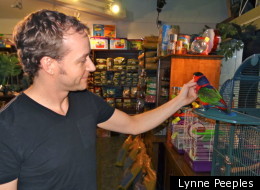
Kopulos pulled a brightly colored black capped lory named O.J. out of a cage in the middle of the store and began stroking its head. Since he had bred the 7-year-old bird himself, he noted that it had not needed to undergo any quarantine or screening. Years ago, O.J.'s parents had been quarantined before being brought into his collection, as well as tested for all commonly known pathogens that the New Guinea native could harbor.
Most of the other animals Kopulos carries are also screened before going on sale. For any he doesn't screen himself, he includes a discounted vet exam in the price of the pet.
There is a "downside" to all of this, he told HuffPost: "These animals are more expensive." A customer could go to a mainstream pet store, for example, and probably find a wild-caught tortoise for about $100. His price for a captive-raised one is $350.
But if the steady flow of customers during the middle of that Friday afternoon was any indication, his business is doing just fine.
"My goal is to be a role model for other stores and show them that this can work," Kopulos said.
Daszak thinks the economic argument is key. The SARS outbreak, which spread through the wildlife trade in 2003, cost the global economy between $40 and $50 billion, according to Bio Economic Research Associates. Overall, the global trade in illegal pets is estimated to be up to $20 billion per year, with the U.S. as the main importer of wildlife products. As of 2007, the U.S. legal trade was estimated at $2.8 billion.
If the industry just focused more on captive-bred animals, which pose little disease risk and no impact on wild populations, then they could sell them for a premium, suggested Daszak. On top of being safer and more environmentally friendly, he noted, the animals are better-looking and survive longer. However, the true economic impact of a policy is difficult to gauge, given the lack of credible data on such a policy's influence on the probability of an outbreak, said David Finnoff, an economist at the University of Wyoming College of Business.
Dr. Smith of Brown warned that the failure of the Nonnative Wildlife Invasion Prevention Act (H.R. 669) will be repeated unless future versions take into account the economic benefits of the pet trade. The bill, which aims to prevent the introduction of nonnative wildlife species that could negatively impact the economy, environment, other animals or human health, has yet to become law, despite multiple proposals. "The reality is that the wildlife trade does provide significant economic and other benefits to those directly involved, as well as to the public, in both importing and exporting countries," Dr. Smith told HuffPost.
COUNTING ON CONSUMERS
The efforts of organizations such as EcoHealth Alliance, pet stores and the government can only go so far. "The public shares the responsibility to be wise about pet selection and mindful of hygiene in the home," said Dr. Marano.
People in the market for an exotic pet can reference PetWatch or the CDC's Healthy Pets, Healthy People campaign. Further, Dr. Pilny recommends that pet owners take simple measures, such as washing their hands after handling a pet, keeping a baby turtle (or other small pet) out of young children's mouths, and not allowing animals to walk on the kitchen counter or other places where food is prepared.
"If you soak a reptile, make sure to clean the bathtub out," he added. "A lot of reptiles poop while in the bath."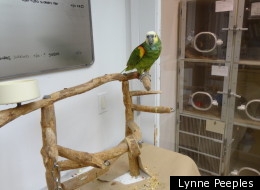
In a corner of The Center for Avian and Exotic Medicine's main boarding room, next to Monico's perch, is the isolation ward. A sick Java sparrow sat inside one of the glass enclosures. The small bird had yet to be screened for pathogens or abnormal bacteria, and therefore had to be temporarily quarantined away from the other animals.
Owners aren't the only ones at risk. Given their frequent contact with animals, veterinarians face potential exposure to disease every day. In fact, veterinarians in the western U.S. have contracted and died from plague, noted Dr. Pilny. "The disease of the dark ages still exists and is carried by fleas," he said, adding that prairie dogs are one of the animals known to harbor those fleas.
When working with patients such as the sick Java sparrow, Dr. Pilny generally takes precautions such as wearing gloves or even a face mask.
It's paid off: "I've never even gotten ringworm," he said.
"There are long lists of zoonotic diseases -- and short lists of what we think are commonly seen. And an even shorter list of what common sense and rationale tells us we're likely to get from that pet," said Dr. Pilny. "We don't feel like exotic pets are this reservoir of horrible diseases and that people should never own them. But it is a matter of being sensible and putting each one in its own case-by-case scenario."
"Communing with wildlife, feeding birds, stroking animals -- this is all a basic part of our human nature," added Daszak. "We don't want to turn people away from animals. We want people to have pets and have that spiritual connection to an animal. We're just suggesting that they make it one that is not going to kill everyone."

